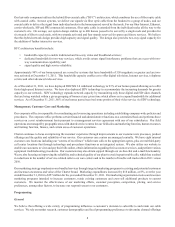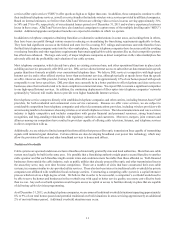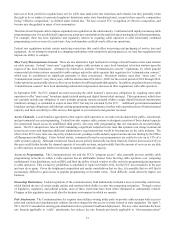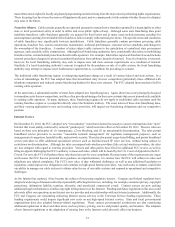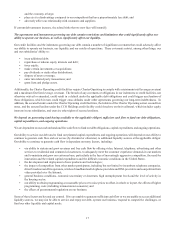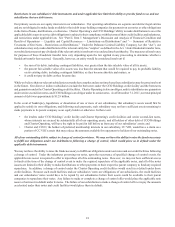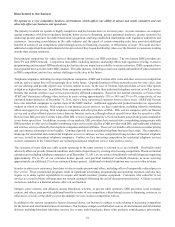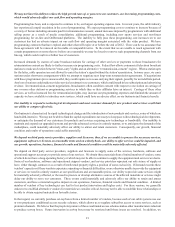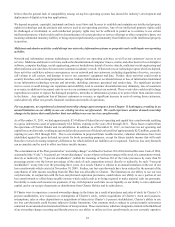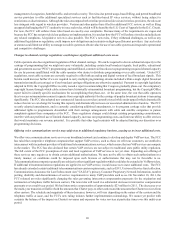Charter 2011 Annual Report Download - page 30
Download and view the complete annual report
Please find page 30 of the 2011 Charter annual report below. You can navigate through the pages in the report by either clicking on the pages listed below, or by using the keyword search tool below to find specific information within the annual report.18
Restrictions in our subsidiaries' debt instruments and under applicable law limit their ability to provide funds to us and our
subsidiaries that are debt issuers.
Our primary assets are our equity interests in our subsidiaries. Our operating subsidiaries are separate and distinct legal entities
and are not obligated to make funds available to their debt issuer holding companies for payments on our notes or other obligations
in the form of loans, distributions, or otherwise. Charter Operating’s and CCO Holdings’ ability to make distributions to us or the
applicable debt issuers to service debt obligations is subject to their compliance with the terms of their credit facilities and indentures,
and restrictions under applicable law. See “Part II. Item 7. Management’s Discussion and Analysis of Financial Condition and
Results of Operations — Liquidity and Capital Resources — Limitations on Distributions” and “— Summary of Restrictive
Covenants of Our Notes – Restrictions on Distributions.” Under the Delaware Limited Liability Company Act (the “Act”), our
subsidiaries may only make distributions if the relevant entity has “surplus” as defined in the Act. Under fraudulent transfer laws,
our subsidiaries may not pay dividends if the relevant entity is insolvent or is rendered insolvent thereby. The measures of insolvency
for purposes of these fraudulent transfer laws vary depending upon the law applied in any proceeding to determine whether a
fraudulent transfer has occurred. Generally, however, an entity would be considered insolvent if:
• the sum of its debts, including contingent liabilities, was greater than the fair saleable value of all its assets;
• the present fair saleable value of its assets was less than the amount that would be required to pay its probable liability
on its existing debts, including contingent liabilities, as they become absolute and mature; or
• it could not pay its debts as they became due.
While we believe that our relevant subsidiaries currently have surplus and are not insolvent, these subsidiaries may become insolvent
in the future. Our direct or indirect subsidiaries include the borrowers under the CCO Holdings credit facility and the borrowers
and guarantors under the Charter Operating credit facilities. Charter Operating is also an obligor, and its subsidiaries are guarantors
under senior second-lien notes, and CCO Holdings is an obligor under its senior notes. As of December 31, 2011, our total principal
amount of debt was approximately $12.8 billion.
In the event of bankruptcy, liquidation, or dissolution of one or more of our subsidiaries, that subsidiary's assets would first be
applied to satisfy its own obligations, and following such payments, such subsidiary may not have sufficient assets remaining to
make payments to its parent company as an equity holder or otherwise. In that event:
• the lenders under CCO Holdings’ credit facility and Charter Operating's credit facilities and senior second-lien notes,
whose interests are secured by substantially all of our operating assets, and all holders of other debt of CCO Holdings
and Charter Operating, will have the right to be paid in full before us from any of our subsidiaries' assets; and
• Charter and CCH I, the holders of preferred membership interests in our subsidiary, CC VIII, would have a claim on a
portion of CC VIII’s assets that may reduce the amounts available for repayment to holders of our outstanding notes.
All of our outstanding debt is subject to change of control provisions. We may not have the ability to raise the funds necessary
to fulfill our obligations under our indebtedness following a change of control, which would place us in default under the
applicable debt instruments.
We may not have the ability to raise the funds necessary to fulfill our obligations under our notes and our credit facilities following
a change of control. Under the indentures governing our notes, upon the occurrence of specified change of control events, the
applicable note issuer is required to offer to repurchase all of its outstanding notes. However, we may not have sufficient access
to funds at the time of the change of control event to make the required repurchase of the applicable notes, and all of the notes
issuers are limited in their ability to make distributions or other payments to their respective parent company to fund any required
repurchase. In addition, a change of control under the Charter Operating credit facilities would result in a default under those
credit facilities. Because such credit facilities and our subsidiaries’ notes are obligations of our subsidiaries, the credit facilities
and our subsidiaries’ notes would have to be repaid by our subsidiaries before their assets could be available to their parent
companies to repurchase their notes. Any failure to make or complete a change of control offer would place the applicable note
issuer or borrower in default under its notes. The failure of our subsidiaries to make a change of control offer or repay the amounts
accelerated under their notes and credit facilities would place them in default.


